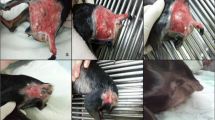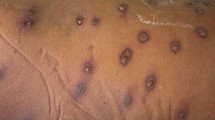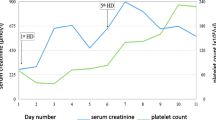Abstract
Introduction
The brown recluse spider (BRS) (Loxosceles reclusa) envenomation can lead to multiple complications, including hemolysis. We present a case of refractory hemolysis after a BRS bite treated with therapeutic plasma exchange (TPE).
Case Report
A 17-year-old female presented with fever, fatigue, and dyspnea. She was diagnosed with sepsis and received intravenous (IV) fluids, inotropic support, and antibiotics. On hospital day 1 she was noted to have skin lesion consistent with a BRS bite and developed hemolysis. Systemic loxoscelism with hemolysis was then suspected and methylprednisolone IV was initiated. She was discharged with a stable HGB on hospital day 3 on oral prednisolone. She was re-admitted 24 h later, with signs of worsening hemolysis. Methylprednisolone was restarted and she was transfused 4 units of packed red blood cells. TPE was initiated due to the refractory hemolysis. Shortly after the TPE session, her clinical and laboratory status improved. She required no further transfusions and was discharged on a steroid taper.
Discussion
TPE is an extra-corporeal method to remove substances from the blood by separating plasma from cellular blood components and replacing it with physiologic fluids. TPE has been used for snake envenomation but there are no reports detailing its use for BRS envenomations. Improvement was associated with TPE initiation and may have been due to removal of complement components activated by the spider venom. This report suggests that TPE could be a possible treatment modality for systemic loxoscelism with refractory hemolysis due to BRS envenomation. Further investigation is warranted.

Similar content being viewed by others
References
Gertsch WJ, Ennik F. The spider genus Loxosceles in North America, Central America, and the West Indies (Araneae, Loxoscelidae). Bull Am Mus Nat Hist. 1983;175:264–360.
Swanson DL, Vetter RS. Bites of brown recluse spiders and suspected necrotic arachnidism. N Engl J Med. 2005;352:700–7.
Rosen JL, Dumitru JK, Langley EW, Meade Olivier CA. Emergency department death from systemic loxoscelism. Ann Emerg Med. 2012;60:439–41.
Yildirim C, Bayraktaroğlu Z, Gunay N, Bozkurt S, Köse A, Yilmaz M. The use of therapeutic plasmapheresis in the treatment of poisoned and snake bite victims: an academic emergency department's experiences. J Clin Apher. 2006;21:219–23.
Gremski LH, Trevisan-Silva D, Ferrer VP, Matsubara FH, Meissner GO, Wille AC, et al. Recent advances in the understanding of brown spider venoms: From the biology of spiders to the molecular mechanisms of toxins. Toxicon. 2014;83:91–120.
Gehrie EA, Nian H, Young PP. Brown Recluse spider bite mediated hemolysis:clinical features, a possible role for complement inhibitor therapy, and reduced RBC surface glycophorin A as a potential biomarker of venom exposure. PLoS One. 2013;8:e76558.
Cacy J, Mold JW. The clinical characteristics of brown recluse spider bites treated by family physicians: an OKPRN Study. Oklahoma Physicians Research Network. J Fam Pract. 1999;48:536–42.
Neuman G, Boodhan S, Wurman I, Koren G, Bitnun A, Kirby-Allen M, et al. Ceftriaxone-induced immune hemolytic anemia. Ann Pharmacother. 2014;48(12):1594–604.
Garratty G. Immune hemolytic anemia caused by drugs. Expert Opin Drug Saf. 2012;11(4):635–42.
Isbister GK. Data collection in clinical toxinology: debunking myths and developing diagnostic algorithms. J Toxicol Clin Toxicol. 2002;40(3):231–7.
Lowry J, Adam DA, Walters H, Wasserman G. Clinical and ancillary data in children with brown recluse spider envenomation. Clin Toxicol. 2011;49:517.
Novak R, Mehesh Kumar AP, Thompson E, Billmeier GJ. Severe systemic toxicity from a spider bite in a six-year-old boy. J Tenn Med Assoc. 1979;72(2):110–1.
WE N. Hemolytic anemia of necrotic arachnidism. Am J Med. 1961;31:801–7.
McLeod B, Szczepiorkowski ZM, Weinstein R, Winters JL, editors. Apheresis: principles and practice. Bethesda, MD: AABB Press; 2010.
Ibrahim RB, Liu C, Cronin SM, Murphy BC, Cha R, Swerdlow P, et al. Drug removal by plasmapheresis: an evidence-based review. Pharmacotherapy. 2007;27(11):1529–49.
Hofmann G, Bauernhofer T, Krippl P, Lang-Loidolt D, Horn S, Goessler W, et al. Plasmapheresis reverses all side-effects of a cisplatin overdose—a case report and treatment recommendation. BMC Cancer. 2006;6:1.
Lane DR, Youse JS. Coombs-positive hemolytic anemia secondary to brown recluse spider bite: a review of the literature and discussion of treatment. Cutis. 2004;74:341–7.
Conflict of Interest
There are no conflicts to declare.
Author information
Authors and Affiliations
Corresponding author
Additional information
This paper has not previously been presented and was not funded.
Rights and permissions
About this article
Cite this article
Abraham, M., Tilzer, L., Hoehn, K.S. et al. Therapeutic Plasma Exchange for Refractory Hemolysis After Brown Recluse Spider (Loxosceles reclusa) Envenomation. J. Med. Toxicol. 11, 364–367 (2015). https://doi.org/10.1007/s13181-015-0485-9
Published:
Issue Date:
DOI: https://doi.org/10.1007/s13181-015-0485-9




